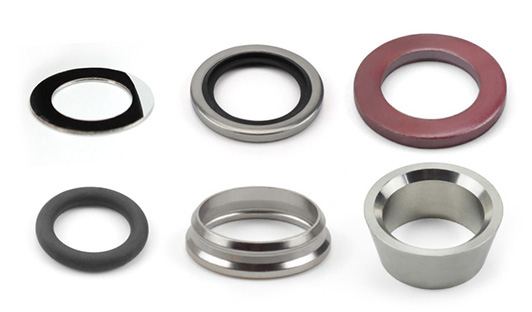
1. Surface condition of the sealing surface: the shape and surface roughness of the sealing surface have a certain influence on the sealing performance, and the smooth surface is conducive to the sealing. Soft gasket is not sensitive to surface condition because it is easy to deform, while hard gasket has great influence on surface condition.
2. Contact width of sealing surface: the greater the contact width between sealing surface and gasket or packing, the longer the path of fluid leakage and the greater the loss of flow resistance, which is conducive to sealing. But under the same pressing force, the larger the contact width is, the smaller the sealing pressure will be. Therefore, the appropriate contact width should be found according to the material of the seal.
3. Fluid properties: the viscosity of the liquid has a great influence on the sealing performance of the packing and gasket. The fluid with high viscosity is easy to seal due to its poor fluidity. The viscosity of liquid is much higher than that of gas, so liquid is easier to seal than gas. Saturated steam is easier to seal than superheated steam because it can condense out droplets and block the leakage channel between sealing surfaces. The larger the molecular volume of the fluid, the easier it is to be blocked by the narrow sealing gap, so it is easy to seal. The wettability of the liquid to the seal material also has a certain influence on the seal. The liquid which is easy to infiltrate is easy to leak because of the capillary action of the micropores in the gasket and packing.
4. Fluid temperature: the temperature affects the viscosity of the liquid, thus affecting the sealing performance. With the increase of temperature, the viscosity of liquid decreases and that of gas increases. On the other hand, the change of temperature often results in the deformation of the sealing components, which is easy to cause leakage.
5. Material of gasket and packing: soft material is easy to produce elastic or plastic deformation under the action of preload, thus blocking the channel of fluid leakage, which is conducive to sealing; however, soft material generally cannot withstand the action of high-pressure fluid. The corrosion resistance, heat resistance, compactness and hydrophilicity of sealing materials have certain influence on the sealing.
6. Sealing surface specific pressure: the normal force on the unit contact surface between sealing surfaces is called sealing specific pressure. The size of sealing surface specific pressure is an important factor affecting the sealing performance of gasket or packing. Usually, a certain specific pressure is produced on the sealing surface by applying pre tightening force to deform the seal, so as to reduce or eliminate the gap between the sealing contact surfaces and prevent the fluid from passing through, so as to achieve the purpose of sealing. It should be pointed out that the effect of fluid pressure will change the specific pressure of sealing surface. Although the increase of the specific pressure of the sealing surface is beneficial to the sealing, it is limited by the extrusion strength of the sealing material; for the dynamic seal, the increase of the specific pressure of the sealing surface will also cause the corresponding increase of the friction resistance.
7. Influence of external conditions: vibration of pipeline system, deformation of connecting components, deviation of installation position and other reasons will produce additional force on seals, which will have adverse effects on seals. Especially the vibration will make the compression force between the sealing surfaces change periodically, and make the connecting bolts loose, resulting in seal failure. The cause of vibration may be external or internal. In order to make the seal reliable, we must seriously consider the above factors, and the manufacture and selection of sealing gasket and packing are very important.
Post time: Feb-23-2022